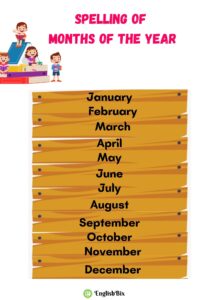Today we are going to have a look at the spellings of all the 12 months of the year and also learn their correct order.
We start our year with cold January as the first month, then It is followed by 11 months. and finally December is the 12th and last month of the year.
Spellings for Months of the Year
Use the following table to learn how to correctly spell months of the years for kindergarten school kids:
| Order of Months | Month Names | Number of Days |
| 1st | January | 31 |
| 2nd | February | 28 / 29 |
| 3rd | March | 31 |
| 4th | April | 30 |
| 5th | May | 31 |
| 6th | June | 30 |
| 7th | July | 31 |
| 8th | August | 30 |
| 9th | September | 31 |
| 10th | October | 30 |
| 11th | November | 31 |
| 12th | December | 30 |
As you can see that a year is divided into 12 months according to a modern-day Gregorian calendar.
Each month has either 28, 29, 30, or 31 days during a common year, which has 365 days, but when it is a leap year, which usually occur in every 4 years, we add an extra day also known as leap day on 29 February, making the year 366 days long.
Let’s have a look at each month in detail:
- January: It’s the first month of the year. In the Northern Hemisphere marks the start of winter, while in the Southern the summertime is just beginning.
- February: It’s the shortest month of the year, and it’s very special, February has 28 days usually, but every 4 years, it has got one more day to end up with 29
- March: The spring month! At least in the Northern Hemisphere. In the Southern Hemisphere, March marks the start of fall.
- April: In some places in the Northern Hemisphere, it comes with lots of rain and windy weather.
- May: It marks the beginning of Winter on the Southern Hemisphere, and it marks the end of Spring, which lasts until June, in the Northern Hemisphere.
- June: For the people living in the Southern Hemisphere, it comes with cold temperatures, but in the Northern region, it represents the start of summer and sunny days.
- July: It is midsummer for the Northern region, and frequently associated with the start of vacations.
- August: A cold month for the Southern region that marks the end of their Winter.
- September: It’s the ninth month of the year and the start of Fall in the Northern region.
- October: Leaves start to fall in some places, while days get a bit warmer in others.
- November: The Northern Hemisphere gets colder temperatures each day, while in the other half of the world the temperature keeps rising.
- December: It is the last month of the year, it marks the beginning of summer for the Southern Hemisphere, while in the Northern one is the start of wintertime.
The abbreviations or short forms shown are the most common. When using abbreviations for the names of months, it is important to maintain consistency throughout.
Abbreviations of the Names of the Months
| Month | Abbreviation |
| January | Jan. |
| February | Feb. |
| March | Mar. |
| April | Apr. |
| May | May |
| June | June |
| July | July |
| August | Aug. |
| September | Sept. |
| October | Oct. |
| November | Nov. |
| December | Dec. |
With EnglishBix you can also learn more about abbreviations for the month and different rhymes for kids to learn month names. Keep following the latest blogs for learning English content.

Find months of the year worksheets for you kids to practice what they have learned.
Quick Links

